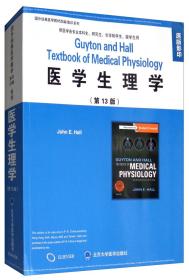
医学生理学(第13版)(影印)
全新正版 假一赔十 可开发票
¥ 163.82 5.9折 ¥ 280 全新
库存6件
北京东城
认证卖家担保交易快速发货售后保障
作者John,E.Hall 著
出版社北京大学医学出版社有限公司
ISBN9787565919800
出版时间2019-07
装帧平装
开本16开
定价280元
货号1201990043
上书时间2024-09-10
- 最新上架
商品详情
- 品相描述:全新
- 商品描述
-
前言
The first edition ofthe Textbook of Medical Physiology was written by Arthur C. Guyton almost 60 years ago. Unlikemost major medical textbooks, which often have 20 or more authors, the first eight editions of the Textbook of Medical Physiology were written entirely by Dr. Guyton, with each new edition arriving on schedule for nearly 40 years. Dr. Guyton had a gift for communicating complex ideas in a clear and interesting manner that made studying physiology fun. He wrote the book to help students learn physiology, not to impress his professional colleagues.
I worked closely with Dr. Guyton for almost 30 years and had the prMlege of writing parts of the ninth and tenth editions. After Dr. Guyton's tragic death in an automobile accident in 2003, I assumed responsibility for completing the subsequent editions.
For the thirteenth edition of the Textbook of Medical Physiology, I have the same goal as for previous editionsto explain, in language easily understood by students, how the different cells, tissues, and organs of the human body work together to maintain life.
This task has been challenging and fun because our rapidly increasing knowledge of physiology continues to unravel new mysteries of body functions. Advances in molecular and cellular physiology have made it possible to explain many physiology principles in the terminology of molecular and physical sciences rather than in merely a series of separate and unexplained biological phenomena.
The Textbook of Medical Physiology, however, is not a reference book that attempts to provide a compendium of the most recent advances in physiology. This is a book that continues the tradition of being written for students. It focuses on the basic principles of physiology needed to begin a career in the health care professions, such as medicine, dentistry, and nursing, as well as graduate studies in the biological and health sciences. It should also be useful to physicians and health care professionals who wish to review the basic principles needed for understanding the pathophysiology of human disease.
商品简介
自1956年第1版出版以来,《医学生理学》历经修订,现已成为世界范围内的生理学教科书。
新的第13版依然延续了“用简明的语言讲述生理学核心知识”的编写传统,并加入近年来重要的新进展。
《医学生理学(第13版 原版影印)》图片数量进一步增加,生理学与临床的联系及分子机制方面的内容也有较多扩充。
《医学生理学(第13版 原版影印)》应用不同排版方式鲜明区分不同层次的知识:与维持人体“稳态”相关的生理学核心知识使用大号字体,其他支持性信息或举例使用小号字体并置在灰蓝色背景中。
《医学生理学(第13版 原版影印)》正文中的关键知识以总结性图片或表格的形式进一步被提炼、再现。
《医学生理学(第13版 原版影印)》书末增加实验室常见指标的正常参考值,以方便快速查阅。
目录
Unit 1 Introduction to Physiology: The Cell and General Physiology
CHAPTER 1
Funaional Organization of the Human
Body and Control of the "Internal Environment"
Cells Are the Living Units of the Body
Extracellular Fluid-The "Internal Environment"
Homeostasis-Maintenance of a Nearly Constant Internal Environment
Control Systems of the Body
Summary-Automaticity of the Body
CHAPTER 2 The Cell and Its Functions
Organization of the Cell
Physical Structure of the Cell
Comparison of the Animal Cell With Precellular Forms of Life
Functional Systems of the Cell
Locomotion of Cells
CHAPTER 3
Genetic Control of Protein Synthesis, Cell Function, and Cell Reproduction
Genes in the Cell Nucleus Control Protein Synthesis
The DNA Code in the Cell Nucleus Is
Transferred to RNA Code in the Cell Cytoplasm-The Process of Transcription
Synthesis of Other Substances in the Cell
Control of Gene Function and Biochemical Activity in Cells
The DNA-Genetic System Controls Cell Reproduction
Cell Differentiation
Apoptosis-Programmed Cell Death Cancer
……
Unit 2 Membrane Physiology, Nerve, and Muscle
Unit 3 The Heart
Unit 4 The Circulation
Unit 5 The Body Fluids and Kidneys
Unit 6 Blood Cells, Immunity, and Blood Coagulation
UNit 7 Respiration
Unit 8 Aviation, Space. and Deep-Sea Diving Physiology
Unit 9 The Nervous System: A. General Principles and Sensory Physiology
Unit 10 The Nervous System: B.The Special Senses
Unit 11 The Nervous System: C. Motor and Integrative Neurophysiology
Unit 12 Gastrointestinal Physiology
Unit 13 Metabolism and Temperature Regulation
Unit 14 Endocrinology and Reproduction
Unit 15 Sports Physiology
Index
【前言】
相关推荐
— 没有更多了 —


















以下为对购买帮助不大的评价